

تاريخ الرياضيات

الاعداد و نظريتها

تاريخ التحليل

تار يخ الجبر

الهندسة و التبلوجي


الرياضيات في الحضارات المختلفة

العربية

اليونانية

البابلية

الصينية

المايا

المصرية

الهندية


الرياضيات المتقطعة

المنطق

اسس الرياضيات

فلسفة الرياضيات

مواضيع عامة في المنطق


الجبر

الجبر الخطي

الجبر المجرد

الجبر البولياني

مواضيع عامة في الجبر

الضبابية

نظرية المجموعات

نظرية الزمر

نظرية الحلقات والحقول

نظرية الاعداد

نظرية الفئات

حساب المتجهات

المتتاليات-المتسلسلات

المصفوفات و نظريتها

المثلثات


الهندسة

الهندسة المستوية

الهندسة غير المستوية

مواضيع عامة في الهندسة

التفاضل و التكامل


المعادلات التفاضلية و التكاملية

معادلات تفاضلية

معادلات تكاملية

مواضيع عامة في المعادلات


التحليل

التحليل العددي

التحليل العقدي

التحليل الدالي

مواضيع عامة في التحليل

التحليل الحقيقي

التبلوجيا

نظرية الالعاب

الاحتمالات و الاحصاء

نظرية التحكم

بحوث العمليات

نظرية الكم

الشفرات

الرياضيات التطبيقية

نظريات ومبرهنات


علماء الرياضيات

500AD

500-1499

1000to1499

1500to1599

1600to1649

1650to1699

1700to1749

1750to1779

1780to1799

1800to1819

1820to1829

1830to1839

1840to1849

1850to1859

1860to1864

1865to1869

1870to1874

1875to1879

1880to1884

1885to1889

1890to1894

1895to1899

1900to1904

1905to1909

1910to1914

1915to1919

1920to1924

1925to1929

1930to1939

1940to the present

علماء الرياضيات

الرياضيات في العلوم الاخرى

بحوث و اطاريح جامعية

هل تعلم

طرائق التدريس

الرياضيات العامة

نظرية البيان
Clean Tile Problem
المؤلف:
Buffon, G.
المصدر:
"Essai d,arithmétique morale." Histoire naturelle, générale er particulière, Supplément 4
الجزء والصفحة:
...
8-3-2021
2003
Clean Tile Problem
Clean tile is a game investigated by Buffon (1777) in which players bet on the number of different tiles a thrown coin will partially cover on a floor that is regularly tiled. Buffon investigated the probabilities on a triangular grid, square grid, hexagonal grid, and grid composed of rhombi. Assume that the side length of the tile  is greater than the coin diameter
is greater than the coin diameter  . Then, on a square grid, it is possible for a coin to land so that it partially covers 1, 2, 3, or 4 tiles. On a triangular grid, it can land on 1, 2, 3, 4, or 6 tiles. On a hexagonal grid, it can land on 1, 2, or 3 tiles.
. Then, on a square grid, it is possible for a coin to land so that it partially covers 1, 2, 3, or 4 tiles. On a triangular grid, it can land on 1, 2, 3, 4, or 6 tiles. On a hexagonal grid, it can land on 1, 2, or 3 tiles.
Special cases of this game give the Buffon-Laplace needle problem (for a square grid) and Buffon's needle problem (for infinite equally spaced parallel lines).
 |
 |
As shown in the figure above, on a square grid with tile edge length  , the probability that a coin of diameter
, the probability that a coin of diameter  will lie entirely on a single tile (indicated by yellow disks in the figure) is given by
will lie entirely on a single tile (indicated by yellow disks in the figure) is given by
 |
(1) |
since the shortening of the side of a square obtained by insetting from a square of side length  by the radius of the coin
by the radius of the coin  is given by
is given by
 |
(2) |
The probability that it will lie on two or more (indicated by red disks) is just
 |
(3) |
For the game to be fair with two players betting on (1) a single tile or (2) two or more tiles, these quantities must be equal, which gives
 |
(4) |
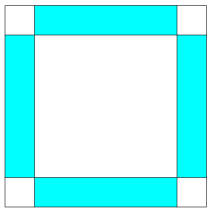
The probability of landing on exactly two tiles is the ratio of shaded area in the above figure to the tile size, namely
 |
 |
 |
(5) |
 |
 |
 |
(6) |
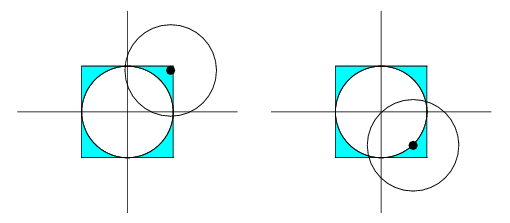
On a square grid, the probability of a coin landing on exactly three tiles is the fraction of a tile covered by the region illustrated in the figure above,
 |
(7) |
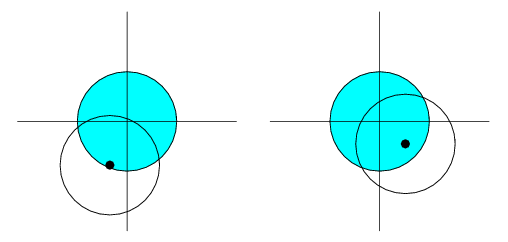
Similarly, the probability of a coin landing on four tiles is the fraction of a tile covered by a disk, as illustrated in the figure above,
 |
(8) |
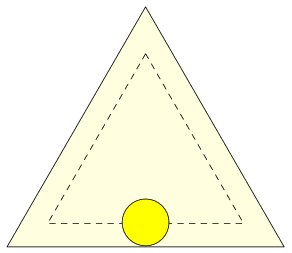 |
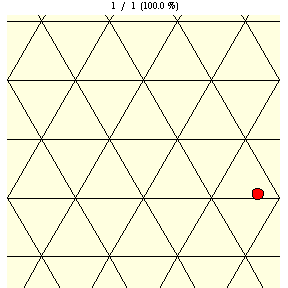 |
As shown in the figure above, on a triangular grid with tile edge length  , the probability that a coin of diameter
, the probability that a coin of diameter  will lie entirely on a single tile is given by
will lie entirely on a single tile is given by
 |
(9) |
since the shortening of the side of an equilateral triangle obtained by insetting from a triangle of side length  by the radius of the coin
by the radius of the coin  is
is
 |
(10) |
The probability that it will lie on two or more is just
 |
(11) |
For the game to be fair with two players betting on (1) a single tile or (2) two or more tiles, these quantities must be equal, which gives
 |
(12) |
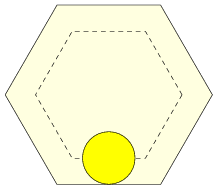
As shown in the figure above, on a hexagonal grid with tile edge length  , the probability that a coin of diameter
, the probability that a coin of diameter  will lie entirely on a single tile is given by
will lie entirely on a single tile is given by
 |
(13) |
since the shortening of the side of a regular hexagon obtained by insetting from a triangle of side length  by the radius of the coin
by the radius of the coin  is
is
 |
(14) |
The probability that it will lie on two or more is just
 |
(15) |
For the game to be fair with two players betting on (1) a single tile or (2) two or more tiles, these quantities must be equal, which gives
 |
(16) |
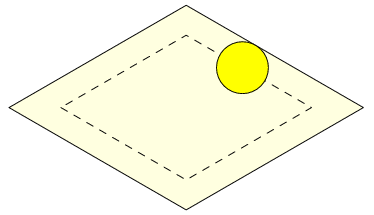
In a quadrilateral tiling formed by rhombi with opening angle  , insetting from a rhombus of side length
, insetting from a rhombus of side length  gives
gives
 |
 |
 |
(17) |
 |
 |
 |
(18) |
so
 |
(19) |
Therefore, the probability that a coin will lie on a single tile is
 |
 |
 |
(20) |
 |
 |
 |
(21) |
The probability that it will lie on two or more is just
 |
(22) |
For the game to be fair with two players betting on (1) a single tile or (2) two or more tiles, these quantities must be equal, which gives
 |
(23) |
As expected, this reduces to the square case for  .
.
REFERENCES:
Buffon, G. "Essai d'arithmétique morale." Histoire naturelle, générale er particulière, Supplément 4, 46-123, 1777.
Mathai, A. M. "The Clean Tile Problem." §1.1.1 in An Introduction to Geometrical Probability: Distributional Aspects with Applications. Taylor & Francis: pp. 2-5, 1999.
Solomon, H. Geometric Probability. Philadelphia, PA: SIAM, 1978.
 الاكثر قراءة في الاحتمالات و الاحصاء
الاكثر قراءة في الاحتمالات و الاحصاء
 اخر الاخبار
اخر الاخبار
اخبار العتبة العباسية المقدسة

الآخبار الصحية















 قسم الشؤون الفكرية يصدر كتاباً يوثق تاريخ السدانة في العتبة العباسية المقدسة
قسم الشؤون الفكرية يصدر كتاباً يوثق تاريخ السدانة في العتبة العباسية المقدسة "المهمة".. إصدار قصصي يوثّق القصص الفائزة في مسابقة فتوى الدفاع المقدسة للقصة القصيرة
"المهمة".. إصدار قصصي يوثّق القصص الفائزة في مسابقة فتوى الدفاع المقدسة للقصة القصيرة (نوافذ).. إصدار أدبي يوثق القصص الفائزة في مسابقة الإمام العسكري (عليه السلام)
(نوافذ).. إصدار أدبي يوثق القصص الفائزة في مسابقة الإمام العسكري (عليه السلام)


















